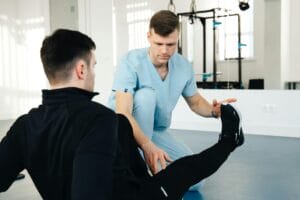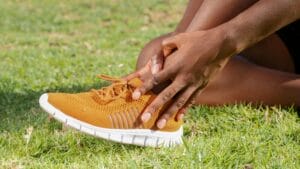
Sports Rehabilitation and Sports Injury Treatment: A comprehensive scientific approach
1. Introduction
Definition of Sports Rehabilitation
Sports rehabilitation is a systematic process aimed at restoring physical fitness and function to athletes after an injury. Rehabilitation focuses on rebuilding strength, flexibility, endurance, and motor coordination, while restoring balance to injured muscles and joints. Sports rehabilitation is not just a step to return to sporting activity, it is a vital part of maintaining high performance and preventing recurring injuries.
The importance of sports rehabilitation
Sports rehabilitation is extremely important in restoring the level of fitness required for optimal performance. After an injury, significant changes occur in the body, such as loss of muscle mass and deterioration of flexibility, leading to a reduced ability to perform. With proper rehabilitation programs, athletes can gradually restore these abilities, reducing the risk of future injuries and improving athletic performance in the long term.
Why is it necessary after injuries?
Sports injuries can lead to long-term disability if not treated properly. Rehabilitation helps avoid injury-related complications such as chronic pain, reduced mobility, or even permanent disabilities. In addition, sports rehabilitation helps in a gradual return to competition, taking into account the athlete's physical condition to ensure that the injury does not recur.
2. Stages of Sports Rehabilitation
Initial assessment and diagnosis
The first step in sports rehabilitation is an accurate assessment of the injury. This assessment begins with a careful analysis of movement and evaluation of symptoms, including pain and motor limitations. X-rays or MRIs may be used to determine the extent of the injury. It is essential to consult with sports rehabilitation or physical therapy specialists to ensure an accurate diagnosis and determine the appropriate treatment.
Initial Treatment Phase
After diagnosis, initial treatment begins. This treatment includes techniques to reduce inflammation and pain such as using ice, rest, and applying compression. This phase may also include the use of non-steroidal anti-inflammatory drugs (NSAIDs). Rehabilitation should begin as soon as possible after the condition is stabilized to avoid muscle atrophy or stiffness in the joints.
Gradual Rehabilitation Phase
Progressive rehabilitation involves rebuilding physical capacity in a consistent manner. This begins with gentle exercises to increase flexibility and gradually improve strength. Emphasis is placed on strengthening the muscles surrounding the injured joint and modifying the range of motion to maintain balance between all muscles. Increasing the training load must be carefully graded to avoid overstressing the injured area.
Back to sports
Assessing an athlete's readiness to return to competition is based on several criteria, including pain level, strength gained, and restoration of full flexibility. The athlete should be able to perform exercises that require exertion similar to the sport they are practicing before returning to competition. Preventive strategies should be implemented to avoid re-injury, such as improving training techniques and adhering to a prevention program.
3. Physical therapy and sports rehabilitation tools
Physical therapy as an essential part of rehabilitation
Physical therapy is an essential part of the sports rehabilitation process. A physical therapist uses manual techniques such as sports massage and stretching exercises to improve muscle flexibility and restore normal movement. Physical therapy also helps reduce pain and inflammation.
Rehabilitation aids
Several technical tools are used to support rehabilitation, such as ultrasound therapy, which helps accelerate tissue healing. In addition, electrical muscle stimulation and mechanical devices can be used to strengthen injured muscles and improve mobility.
Modern technology in rehabilitation
In recent years, modern technology has become an integral part of sports rehabilitation. Kinetic analysis technologies provide accurate data about body movement, helping to identify and correct areas of movement dysfunction. Smart devices such as sports watches and performance tracking software can provide detailed information about rehabilitation progress, enabling specialists to modify treatment programs based on real-time performance analysis.
4. Recommended exercises for each type of injury
Knee injuries
Knee injuries, such as torn ligaments, are common in high-impact sports. Exercises used in rehabilitation include strengthening the muscles around the knee such as the quadriceps and thighs, along with balance exercises such as single-leg jumps and stretches.
Shoulder injuries
Shoulder injuries are often caused by repetitive motions or collisions in sports such as swimming or weightlifting. Appropriate exercises include stretching to improve range of motion, as well as strengthening the muscles around the shoulder joint using light weights or resistance.
Muscle injuries
Muscle cramps are one of the most common injuries among athletes. Exercise progression can help avoid repetitive muscle strain. It is essential to strengthen damaged muscles with strength and stretching exercises and gradually increase endurance.
Tendon injuries
Tendon injuries, such as tendonitis, require targeted strengthening exercises to improve tendon flexibility and reduce swelling. These include light resistance movements and dynamic exercises.
5. The importance of preventing recurring injuries
Preventive programs
Repetitive injury prevention programs involve setting up special training programs aimed at improving strength, flexibility, and endurance. Athletes should follow these programs on a regular basis to avoid overloading joints and muscles.
Correcting motor errors
Training in correct techniques is crucial in preventing recurring injuries. Athletes should work on correcting motor errors and learn how to execute movements correctly to avoid overstressing certain areas of the body.
Flexibility and balance
Maintaining flexibility and balance is essential for preventing injuries. Exercises that focus on improving flexibility, such as stretching, help keep joints and muscles moving properly, reducing the likelihood of injuries.
6. Nutrition and its role in sports rehabilitation
The importance of nutrition in speeding up recovery
NUTRITION PLAYS A VITAL ROLE IN THE REHABILITATION PROCESS. NUTRIENTS SUCH AS PROTEINS CONTRIBUTE TO BUILDING DAMAGED MUSCLES, WHILE HEALTHY FATS AND CARBOHYDRATES HELP PROVIDE ENERGY FOR THE HEALING PROCESS. VITAMINS AND MINERALS, SUCH AS VITAMIN D AND CALCIUM, PLAY A ROLE IN STRENGTHENING BONES AND JOINTS.
Nutritional supplements that support rehabilitation
Supplements useful in rehabilitation include proteins, amino acids such as glutamine, and joint support supplements such as glucosamine. These supplements promote tissue healing and optimize the recovery process.
7. Real-life examples (practical cases)
Cases from famous athletes
World-class athletes such as Rafael Nadal have suffered complex injuries such as knee or shoulder injuries and have undergone rigorous rehabilitation programs to successfully return to competition. Such cases provide useful lessons about the effectiveness of advanced sports rehabilitation programs.
Comparison of different methods
In sports like football, different rehabilitation programs are used compared to other sports like athletics. Each sport requires specialized programs based on the type of effort exerted and the muscles used.
8. Rehabilitation Challenges
Physical and psychological challenges
An athlete may face physical challenges such as chronic pain or a decline in fitness, as well as psychological challenges such as anxiety about not being able to return to the same level as before.
Coping with pain
Coping with pain during the rehabilitation process is critical. Athletes need to learn how to differentiate between pain that indicates positive progress and pain that may indicate deterioration.
9. Conclusion
Re-emphasize the importance of rehabilitation
Sports rehabilitation is a comprehensive process aimed at safely and effectively restoring physical ability after injuries. Rehabilitation requires specialized supervision and thoughtful programs to ensure a full recovery.
Encourage adherence to rehabilitation programs
It is imperative that athletes adhere to a full rehabilitation program to ensure a full recovery and return to sport without risking re-injury.
The PerfUp Center offers consultations and sports rehabilitation programs that you can access through the following link:
Also, if you are looking to become a qualified coach, the Perf Up Sports Center offers three levels of attendance courses to qualify sports coaches, and you can also sign up for the online coach course through the following link:






